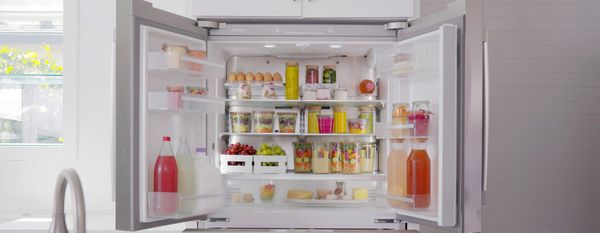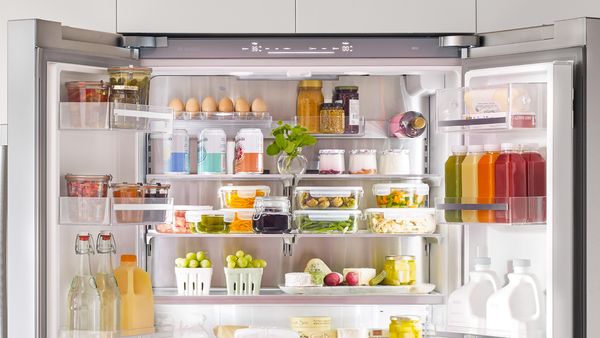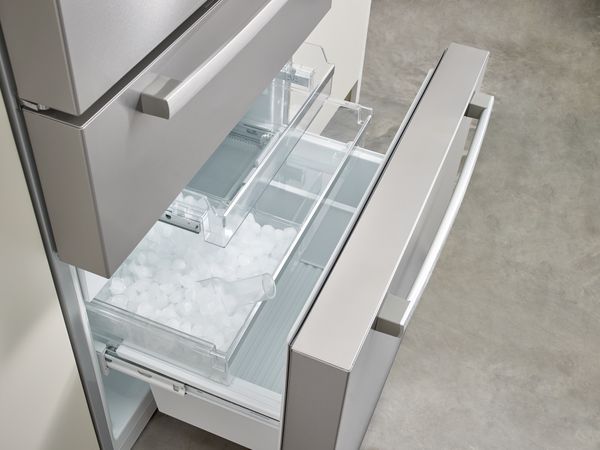
The Importance of Setting Correct Freezer and Refrigerator Temperatures
At Bosch, our unwavering commitment to excellence goes beyond crafting top-tier appliances; it extends to providing you with valuable information to enhance your experience.
Ensuring that your refrigerator and freezer maintain the correct temperatures is crucial. This practice not only extends the freshness of your food but also ensures food safety, boosts energy efficiency, and leads to overall cost savings. By understanding and implementing the right temperature settings, you can trust that you're making the most of your appliance and safeguarding the well-being of your loved ones.

What Temperature Should a Refrigerator Be?
According to the US Department of Energy, the recommended temperature range to ensure food safety and optimal freshness is between 35°F (1.7°C) and 38°F (3.3°C).* Maintaining this range effectively prevents harmful bacteria growth and helps your food items remain in their best quality for longer.
Certain special food items may have unique temperature requirements, and it's essential to consider these for optimal storage:
- Dairy products, particularly milk and soft cheeses, should be stored at the colder end of the recommended range. This ensures their freshness and prevents spoilage.
- Delicate produce such as lettuce and berries can benefit from slightly higher temperatures within the range to prevent freezing or wilting.
- If you're concerned about the freshness of your sensitive foods, innovations like Bosch's FreshProtect®, available in certain refrigerators, can assist in prolonging the freshness of these items.
Always remember to refer to the storage guidelines on product packaging or refer to food safety resources for specific items to ensure the best care for your groceries.
*Source: https://www.energy.gov/energysaver/refrigerator-freezer-use-and-temperature-tips

What Temperature Should a Freezer Be?
To keep your food fresh and safe, set your freezer to 0°F (-18°C) or lower. This temperature ensures that food is stored in a solid, frozen state, preventing growth of harmful bacteria, and preserving your food's quality and nutrition.
For most items, this standard temperature works perfectly. However, here are some specific considerations:
- Ice Cream and Desserts: Some frozen treats may prefer -10°F (-23°C) to -20°F (-29°C) to maintain a creamy texture without becoming too hard.
- High-Fat Fish: For high-fat fish like salmon, storing them at the lower end of the recommended range helps maintain texture and flavor.
Always check packaging instructions or consult specialized guidelines for unique frozen items to ensure they're stored optimally. Your freezer temperature plays a crucial role in keeping your food fresh and safe.
How to Check and Adjust Your Fridge and Freezer Temperatures
Regular monitoring of your fridge and freezer temperatures is crucial to ensure that your food remains safe to eat and retains its quality. Inconsistent or incorrect temperatures can lead to spoilage, freezer burn, or the growth of harmful bacteria, compromising both the taste and safety of your food.
For those with newer appliances:
1. Check the Built-in Thermometers: Many modern fridges come equipped with built-in thermometers that display the current temperature. Regularly check this display to ensure it remains within the recommended range. Some Bosch smart refrigerators, like those with the Home Connect app , allow you to remotely monitor and control your refrigerator from your smartphone, wherever you are.
2. Adjust the Temperature (if needed): If the built-in reading indicates that the temperature is off, use the appliance's control panel or settings to adjust.
3. Wait and Recheck: After making changes, wait 24 hours for the temperature to stabilize, then check again to ensure it's within the desired range.
4. Bosch's VitaFreshPro® technology takes the guesswork out of food storage by automatically balancing both temperature and humidity levels based on the food setting.
For older models or as an added measure:
1. Install a Refrigerator-Freezer Thermometer: Place a thermometer in the refrigerator and another in the freezer, ensuring they're easily visible for regular checks.
2. Position Correctly: For the most accurate reading, position the thermometer in the center of the compartment, avoiding areas near the door which may be warmer.
3. Adjust the Temperature (if needed): If the thermometer indicates that the temperature is outside the recommended range, adjust using the appliance's temperature control.
4. Wait and Recheck: After making changes, wait 24 hours and then check the temperature again to ensure stability.
What Should You Do If Your Fridge Isn’t Getting Cold?
Discovering that your refrigerator isn't cold enough can be worrying, especially when thinking about food safety and quality. Here's a step-by-step guide on what to do if your refrigerator isn’t getting cold:
1. Verify the Temperature: Before taking any action, double-check the temperature using a separate thermometer to ensure the initial reading was accurate. Place it in the center of the refrigerator for the most accurate reading.
2. Check the Door Seals: Over time, door seals can become dirty or damaged, leading to cold air escaping. Clean the seals with a mild detergent and warm water and inspect them for any cracks or gaps. Replace them if necessary.
- To test the effectiveness of the seal, try the dollar bill test. Place a dollar bill (or any piece of paper) in the door and close it. If you can pull the bill out easily without any resistance, the seal may not be tight enough.
3. Adjust the Thermostat: Use the refrigerator's control panel or dial to adjust the temperature. If you've made changes, wait 24 hours, and then check the temperature again to ensure it has stabilized.
4. Inspect the Vents: Ensure that the vents inside the refrigerator, which allow cold air to circulate, are not blocked by food items. Rearrange your refrigerator's contents if necessary.
- Locate the Vents: Start by identifying where the vents are located inside your refrigerator. They are typically found on the back wall or near the top of the appliance. Some refrigerators may also have vents at the bottom.
- Clean the Vents: Over time, dust and debris can accumulate on the vents. Use a soft brush or cloth to gently clean the vents. Avoid using any harsh chemicals that might contaminate your food.
5. Consider the Room Temperature: If the room where the refrigerator is located is too hot or cold, it can affect the appliance's efficiency. Ensure the room temperature is within a range that's suitable for your refrigerator's optimal performance.
6. Limit Door Opening: Frequently opening the refrigerator door can cause temperature fluctuations, especially in hot environments. Ensure the door is closed properly after use and try to limit the number of times it's opened.
7. Check for Overloading: A refrigerator that's too full can restrict airflow and affect temperature. Ensure there's enough space between items for air to circulate.
- Check the Airflow: Examine the vents closely to see if any food items or containers are blocking them. Common culprits include large containers, bags of vegetables, or items that have been pushed too far back.
- Rearrange items: If you find that items are blocking the vents, rearrange them. Create some space around the vents to ensure proper airflow. Consider using organizers or bins to keep items in place and prevent them from accidentally blocking the vents again.
8. Consult the Manual: Your refrigerator's user manual may have troubleshooting tips specific to your model. Refer to it for additional guidance.
Bosch Refrigerators & Freezers: Accurate Temperatures and More
If you've exhausted all troubleshooting methods and your refrigerator still isn't performing up to par, it might be time to consider an upgrade.
Bosch refrigerators and freezers are renowned for their precision temperature controls, energy efficiency, and innovative features. VitaFresh® technology maintains fresh foods at their peak with precise humidity and temperature controls so you can stay fresh #LikeABosch. With bottom-mount and single column refrigerator options, these refrigerators ensure your food is stored at the optimal temperature.
Explore the range of Bosch refrigerators and learn more about our dedication to energy efficiency at Bosch with our 2023 ENERGY STAR® Partner of the Year award. With Bosch, you can trust in a seamless blend of performance, design, and sustainability.
Refrigeration Temperature FAQs
Answer: In the event of a power outage, it's crucial to minimize the loss of cold air by keeping the refrigerator and freezer doors closed. For extended outages, consider transferring perishables to coolers with ice or using dry ice in the refrigerator to prolong freshness.
Answer: Regularly monitoring temperatures, at least once a day, ensures optimal food preservation. After any significant adjustments or power interruptions, an additional check is advisable.
Answer: The "danger zone" is a critical range between 40°F (4.4°C) and 140°F (60°C) where bacteria can multiply rapidly, posing health risks.
Answer: Ideally, perishable foods should be limited to 2 hours in the "danger zone", but this reduces to just 1 hour in hotter conditions above 90°F (32.2°C).
Answer: Overloading hampers efficient air circulation, leading to uneven cooling, while underloading can waste energy as the fridge cools unnecessary space and may lead to more frequent temperature fluctuations.



